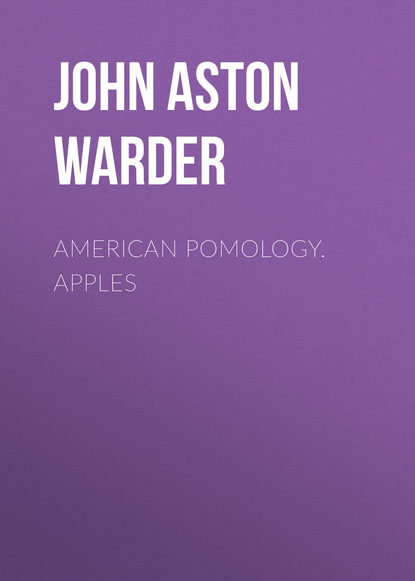 Полная версия
Полная версияAmerican Pomology. Apples
Fruit large, round, slightly conic, regular; Surface smooth, golden yellow; Dots scattered, dark.
Basin small, folded; Eye long, closed.
Cavity wide, very deep, wavy, green; Stem medium or short, crooked.
Core small, globular, open, clasping; Axis short; Seeds numerous, plump, short; Flesh very yellow, breaking, fine-grained, juicy; Flavor sub-acid, rich; Quality best; Use, the dessert; Season, January and February.
Yellow IngestrieThis old English variety has been propagated pretty extensively in the Northwest, and though too small for a profitable market fruit, it has been found desirable on account of its early and abundant productiveness.
Fruit small, globular, truncated, regular; Surface smooth, lemon yellow; Dots minute.
Basin wide, shallow, folded; Eye medium, open; Segments reflexed.
Cavity acute, brown; Stem long, slender.
Core medium, oval, regular, closed, clasping; Seeds few, large, pale; Flesh whitish yellow, breaking, juicy; Flavor sub-acid; Quality barely good; Use, cooking; Season, September, October.
CLASS III.—ROUND APPLESORDER I.—REGULARSECTION II.—SOURSUB-SECTION II.—STRIPEDAmerican Summer Pearmain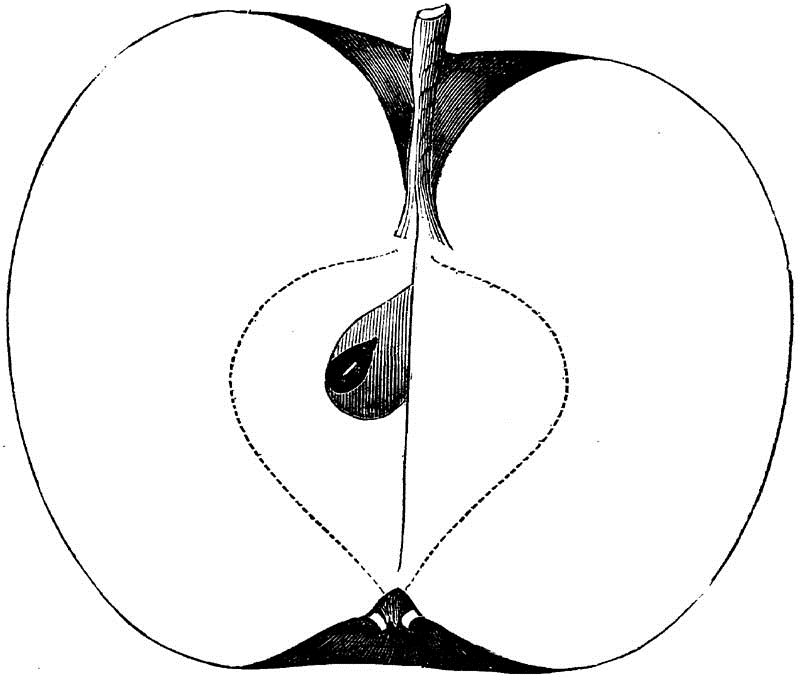
Fig. 207.—AMERICAN SUMMER PEARMAIN.
This delicious apple is supposed to be of American origin. It is essentially a fruit for the amateur; being of slender and slow growth in the nursery, it is not a favorite with the propagators, and though making a large and productive tree in the orchard, it is not profitable as a market variety.
Fruit medium, variable in form, being oblong, round, conic and even oblate, regular or unequal; Surface smooth, greenish yellow, more or less covered with dull purplish red, marbled, and made up of very short splashes, with distinct stripes and splashes of brighter red; Dots minute.
Basin medium, regular; Eye rather large, nearly closed; Segments recurved.
Cavity rather deep, acute, regular; Stem medium to long.
Core small, roundish, closed; Seeds small, pointed; Flesh yellow, exceedingly tender, almost melting, crisp, fine-grained, juicy; Flavor very mild sub-acid, aromatic, deliciously refreshing; Quality best; Use, the dessert; Season, August and September.
Baccalinus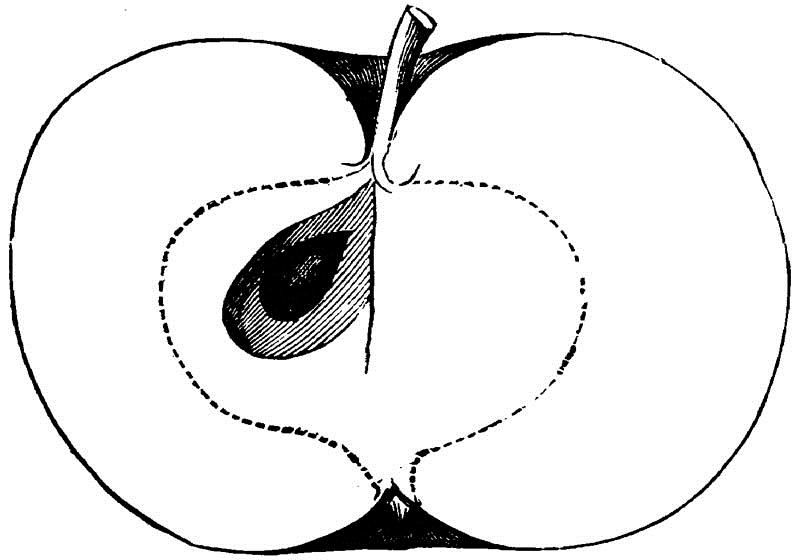
Fig. 208.—BACCALINUS.
Fruited by J.H. Crain, Pulaski County, Illinois, on trees nine years old, which produced ten bushels apiece, showing its productiveness.
This valuable Southern keeper bids fair to become a great favorite.
Tree thrifty, very productive; Fruit small, globular, truncated, regular, handsome; Surface smooth, mixed bright red, and splashed crimson on pale yellow; Dots few, minute.
Basin shallow, wide, regular; Eye small but long, closed; Calyx reflexed.
Cavity deep, regular, brown; Stem medium to long, slender.
Core medium, regular, closed, or slightly open, clasping; Seeds numerous, angular, dark; Flesh yellow, firm, fine-grained, juicy; Flavor sub-acid, agreeable; Use, dessert; Season, December till March or longer; Quality very good.
Beauty of KentA large English apple, well adapted to the kitchen. Tree upright, vigorous, rather productive.
Fruit large to very large, roundish, flattened, somewhat conic, regular; Surface greenish yellow, more or less covered with bright red mixed, and splashed with a darker hue; Dots small.
Basin quite shallow, regular; Eye very small closed.
Cavity medium, acute, wavy, green; Stem medium to short.
Core regular, medium, ovate, slightly open, clasping the eye; Seeds angular, imperfect; Flesh whitish yellow, breaking, juicy; Flavor acid; Quality only good; Use, cooking and market, for which it is well adapted by its size and appearance; Season, September and October.
Ben DavisNEW YORK PIPPIN, &C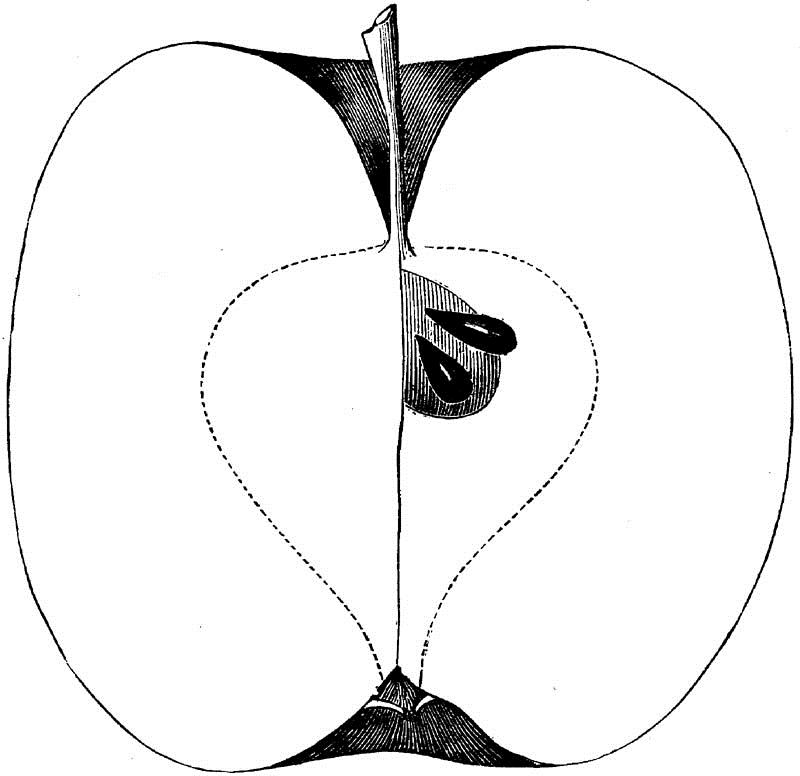
Fig. 209.—BEN DAVIS.
This handsome Southern apple has attained a wonderful notoriety within a few years, and its culture has been greatly extended, not on account of its superlative excellence, but because of its many good qualities as an orchard tree or market fruit. It was long cultivated by Verry Aldrich, in Bureau County, Illinois, and exhibited as New York Pippin, which name gave an idea of its eastern origin, but in other localities its relations point clearly to its source in the South. To Mr. J.S. Downer we are indebted for a knowledge of its present name, and for confirmation of its identity under its several synonyms. This apple may be said to have succeeded as well in the northern parts of Indiana and Illinois as in their southern borders, where it has long been planted; though the northern orchards are still young, they are very promising. The fruit is modified somewhat by a cooler climate, and will keep later than that grown in the South.
Tree remarkably healthy and vigorous, an upright, rapid grower in the nursery, and has numerous short spur-branches along the stem. In the orchard the limbs are set very strongly, and the stems are marked by little mammillar projections or knobs, that are very characteristic. Tree large, spreading, productive, bears early; Shoots long, reddish brown, smooth; Foliage large, dark green.
Fruit large, variable in form, round, often apparently oblong, tapering to the eye, truncated, regular, sometimes inclined, generally very true, as though turned in a lathe; Surface smooth, often polished, yellow covered with mixed red, splashed bright red; Dots minute, scattered.
Basin generally shallow, in large developed specimens deep, abrupt, always regular; Eye large, open; Segments reflexed.
Cavity deep, acute, wavy, brown; Stem medium to long.
Core medium, regular, clasping the eye; Seeds large, plump; Flesh whitish, breaking, tender, juicy; Flavor sub-acid, not rich; Quality only good; Use, market, kitchen; Season, December, January and longer.
BlackburnFound in the markets at Louisville, Kentucky; not much seen elsewhere. Origin unknown, probably Southern.
Fruit large, round, somewhat flattened; Surface dull looking, dull green and gray, with broken stripes of dark dull red; Dots large, gray about the apex.
Basin narrow, regular; Eye medium, closed.
Cavity rather deep, acute, brown; Stem medium, curved, rather stout.
Core flattened, open, clasping; Flesh white, crisp, juicy; Flavor sub-acid, with a peculiar spicy, wild, rather astringent taste, that diminishes with the maturity of the fruit; Quality considered good; Use, family and market; Season September, November. Blackburn is sometimes used as a synonym of Fall Queen, a different fruit.
Capital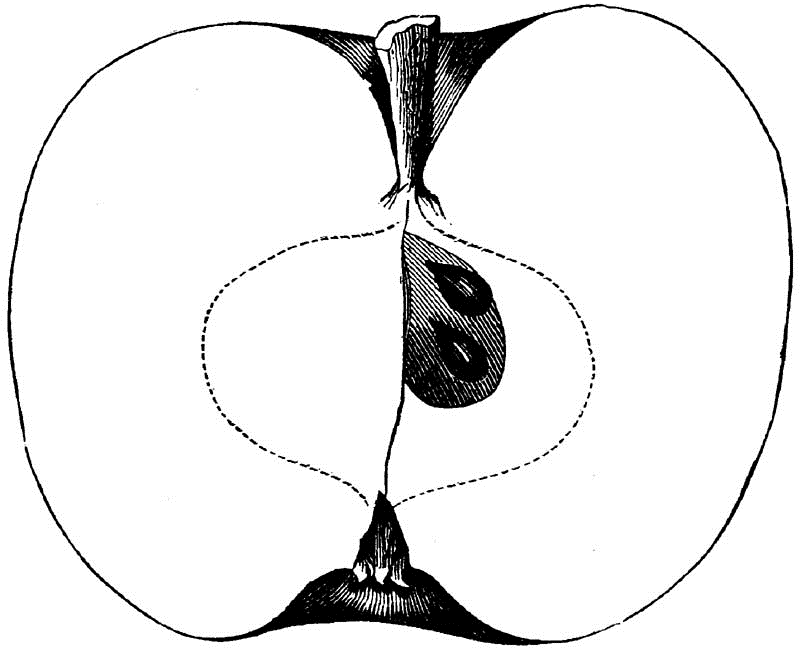
Fig. 210.—CAPITAL.
A seedling of Z.S. Ragan, Clayton, Indiana.
Fruit small, globular, truncate at the ends, regular; Surface smooth, deep red on greenish yellow; Stripes and Dots indistinct.
Basin wide, deep; Eye medium, open, elongated.
Cavity wide, acute, regular; Stem medium.
Core round, open, clasping; Seeds numerous, pointed; Flesh yellow, breaking, juicy; Flavor sub-acid, rich; Quality good; Use, the dessert; Season, December and January.
Carter.—[Of Massachusetts.]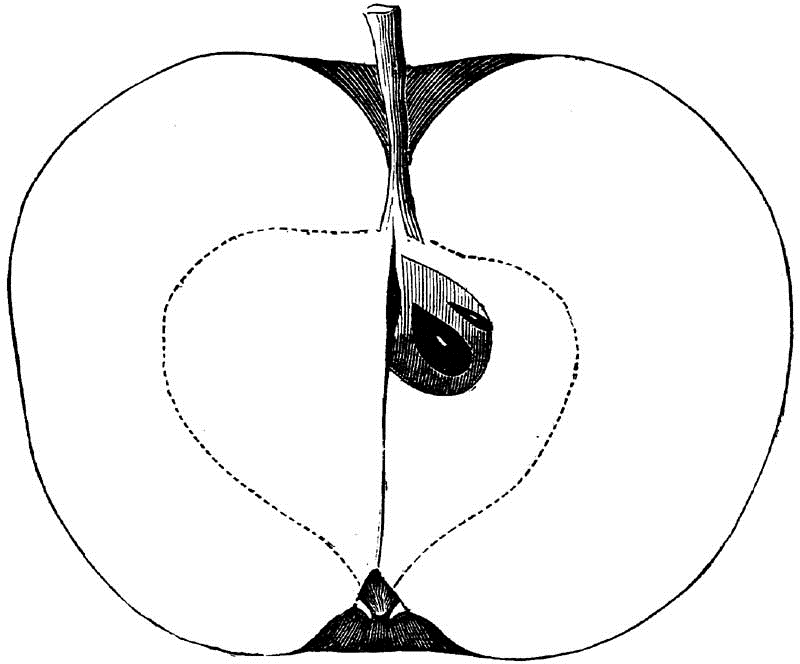
Fig. 211.—CARTER.
Specimens from Luke Lincoln, of Leominster, Mass.
Fruit medium, round, flattened, slightly angular; Surface smooth, yellow, mixed and splashed scarlet; Dots rare, minute.
Basin shallow, folded; Eye small, closed.
Cavity deep, acute, wavy; Stem long.
Core rather large, regular, closed, clasping; Seeds plump and imperfect, pointed; Flesh yellowish white, breaking, juicy; Flavor sub-acid, aromatic; Quality good; Use, table; Season, December, January.
Cary's SummerThis is probably an old variety, but it has not been identified. Specimens from C.C. Cary, near Louisville, Kentucky.
Fruit large, round, flattened, regular; Surface smooth, rich yellow, mixed, splashed, carmine; Dots scattered, minute.
Basin wide, wavy; Eye small, closed.
Cavity deep, narrow, wavy brown; Stem short.
Core medium, roundish, regular, open; Seeds numerous, plump; Flesh yellow, tender, fine-grained, juicy; Flavor sub-acid; Quality very good; Use, table, kitchen, market; Season, June to September.
Cluster Pearmain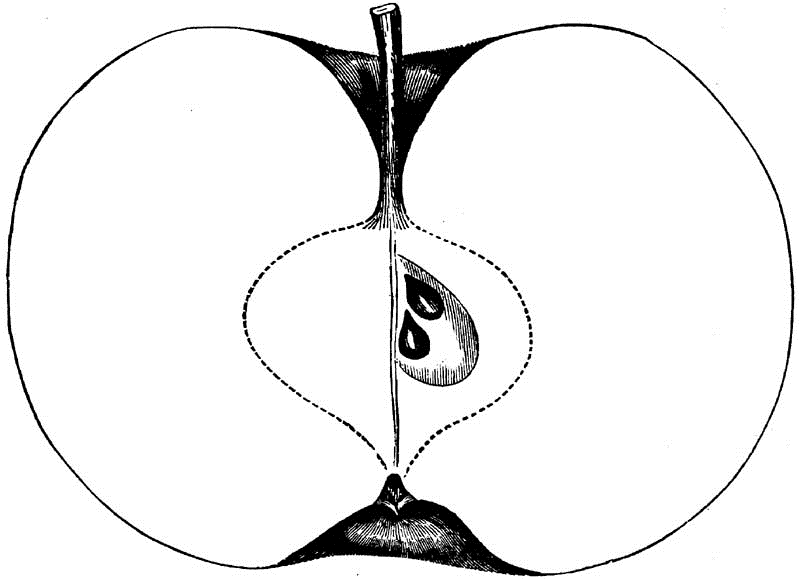
Fig. 212.—CLUSTER PEARMAIN.
Introduced by R. Ragan, of Indiana.
Fruit full medium, round, flattened, regular, inclined; Surface yellowish green, mixed and striped light red; Dots large, numerous, gray and yellow; white bloom.
Basin deep, abrupt, regular; Eye small, closed.
Cavity wide, regular, brown; Stem short.
Core medium, pyriform, nearly closed, clasping; Seeds numerous, angular, dark; Flesh yellowish white, breaking, tender, granular; Flavor sub-acid, aromatic; Quality good to very good; Use, table; Season, September, October. A most acceptable substitute for Rambo, as an amateur's fruit.
CoggeswellOrigin near Norwich, Connecticut. Tree vigorous, upright, productive on alternate years.
Fruit large, uniform, fair, beautiful, round, flattened, regular; Surface smooth, striped red on yellow.
Basin shallow, small; Eye small, closed.
Cavity wide, brown; Stem short.
Flesh yellow, tender, fine-grained, juicy; Flavor mild sub-acid, aromatic, rich; Quality best; Use, table; Season, December to March.
This fruit has been thought to resemble the Ohio Nonpareil, but I think it is different.
Cropsey's FavoriteOriginated with D.W. Cropsey, Plainfield, Will County, Illinois.
Fruit full medium, globular, looking oblong, regular; Surface smooth, yellow, mixed, splashed carmine; Dots few.
Basin medium, regular, russet; Eye medium, closed.
Cavity deep, acute, wavy, green; Stem short to medium.
Core roundish, heart-shaped, closed, meeting the eye; Seeds medium, angular; Flesh yellow, breaking, fine-grained, juicy; Flavor sub-acid, rich; Quality good to very good; Use, table, kitchen; Season, December.
DanielThis delightful autumn dessert apple is grown in Henry County, Indiana.
Fruit medium to small, round, flattened, regular; Surface smooth, mixed scarlet on yellow, splashed carmine; Dots minute.
Basin shallow, regular; Eye medium, closed.
Core wide, regular, open; Seeds numerous, plump; Flesh yellow, very fine-grained, tender, juicy; Flavor sub-acid, aromatic, delicious; Quality best; Use, the dessert; Season, September.
Dan Pearmain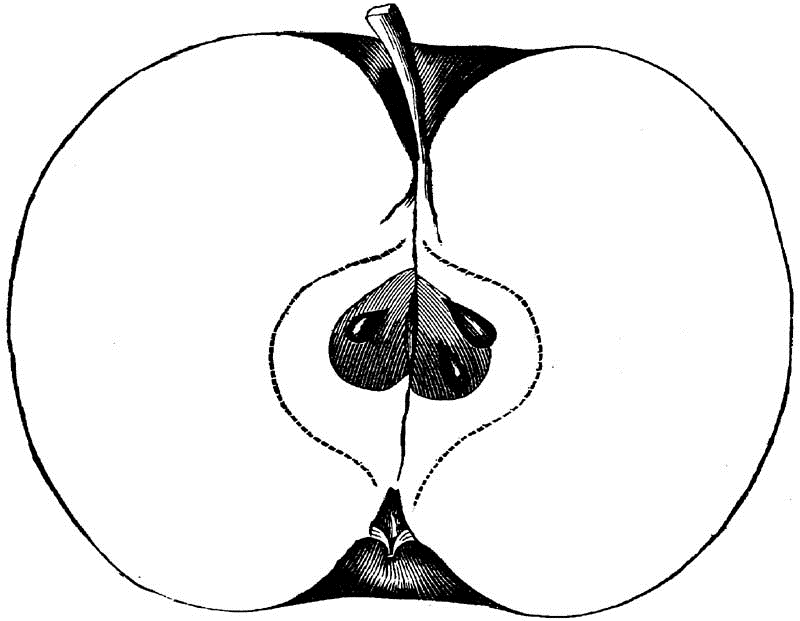
Fig. 213.—DAN PEARMAIN.
This very beautiful seedling was procured by Reuben Ragan from near the battle-field of Tippecanoe, Indiana, where it was found in a seedling orchard.
Fruit medium to small, round, flattened, regular, fair and handsome; Surface yellow, covered with bright red, mixed, striped and splashed; Dots numerous, large, yellow, prominent.
Basin deep, regular or plaited; Eye small, closed.
Cavity deep, acute, regular, sometimes brown; Stem long, slender, red.
Core small, turbinate, closed; Seeds numerous, small, plump; Flesh yellow, breaking, tender; Flavor very mild sub-acid, rich; Quality almost best; Use, table, kitchen, market; on older trees too small for profit; Season, December to March.
DayROYAL PIPPINFrom Reuben Ragan. Fruit large, round, somewhat conic, regular; Surface smooth, yellow, striped, splashed, mottled, carmine; Dots numerous, gray, large.
Basin shallow, folded; Eye small, closed.
Cavity deep, acute, green; Stem medium, clubbed.
Core wide, pyriform, slightly open, clasping; Seeds numerous, pointed, angular, dark; Flesh yellowish white, firm, breaking, granular; Flavor sub-acid; Quality good; Use, kitchen; Season, January. Not destined to take a very high rank.
Doctor Fulcher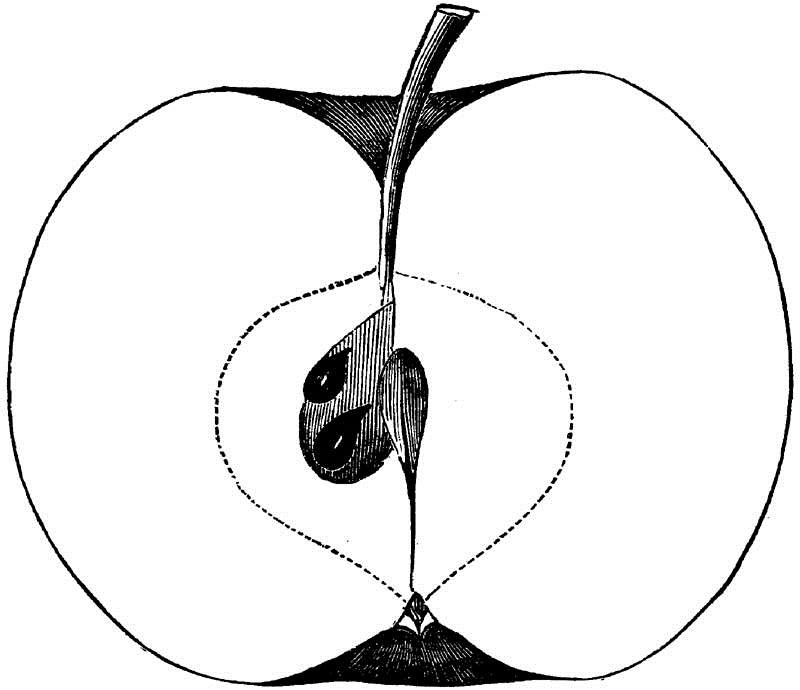
Fig. 214.—DOCTOR FULCHER.
A Southern apple of some merit. Originated in Todd County, Kentucky. Tree thrifty, an early and abundant bearer; Shoots slender; Foliage bright green. Received from J.S. Downer, of Elkton, Kentucky.
Fruit medium, globular, truncated, regular; Surface smooth, yellow, marbled, splashed carmine; Dots minute.
Basin shallow, wavy, russeted, cracked; Eye small, closed.
Cavity sometimes wide, wavy, brown; Stem medium to long.
Core large, turbinate, regular open, meeting the eye; Seeds large, plump; Flesh yellow, fine-grained, tender, melting, juicy; Flavor sub-acid, rich; Quality good, Downer says "best;" Use, table; Season, December, January.
Dutch MignonneREINETTE DOREE—And Several Others in Europe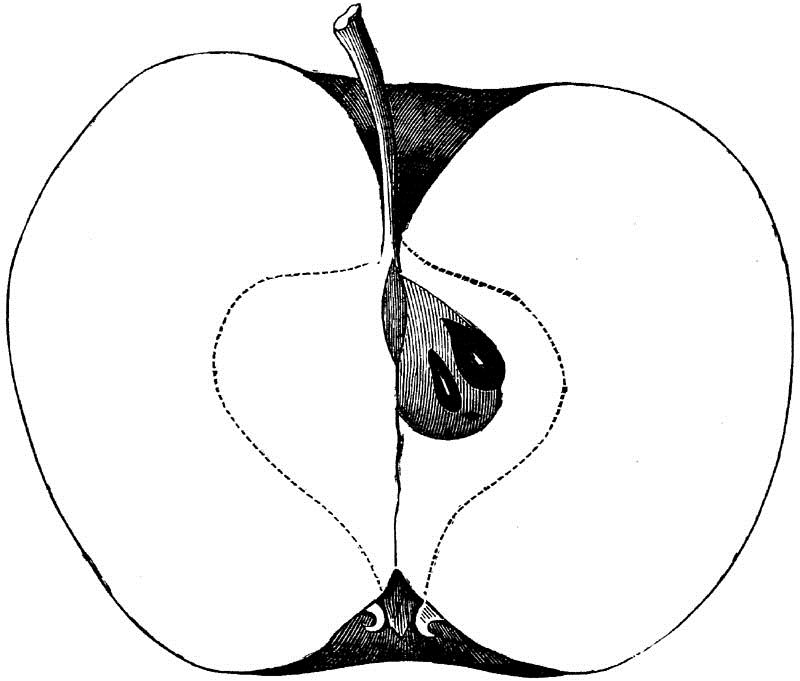
Fig. 215.—DUTCH MIGNONNE.
A fine large apple from Holland. Tree vigorous, upright, productive.
Fruit large or very large, roundish, flattened, sometimes conical, truncated; Surface rough, yellow, covered with red, splashed with bright red; Dots numerous, prominent, fawn-colored.
Basin wide, abrupt, regular; Eye short, wide, open; Segments short.
Cavity medium, acute, regular; Stem medium to long.
Core small, turbinate, regular, clasping; Seeds few, angular imperfect; Flesh yellowish white, breaking, coarse-grained, juicy; Flavor acid to sub-acid, rich; Quality good to very good; Use, kitchen, market, drying; Season, September, October.
Early PennockSHAKER YELLOW—HOMONY, of the South?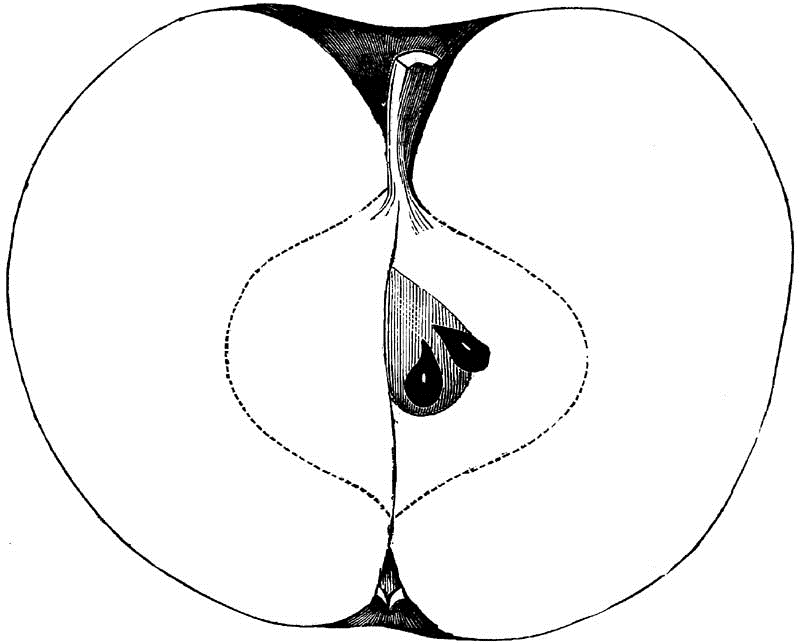
Fig. 216.—EARLY PENNOCK.
Origin unknown. Tree thrifty, upright, early bearer, productive, not long-lived.
Fruit large, variable in form, being sometimes oval, and conical, averaging roundish-conic, regular, handsome, sometimes inclined in the axis; Surface smooth, yellow, partially covered with mixed and striped scarlet, splashed carmine—often the yellow prevails; Dots numerous, dark.
Basin shallow, plaited or regular; Eye small, closed.
Cavity deep, regular, brown; Stem medium or short.
Core long, tapering to both ends, partially open in some, clasping the eye; Seeds large, numerous, plump, dark; Flesh yellow, breaking, rather coarse; Flavor acid; Quality poor; Use, market and kitchen; Season, July and August.
FameuseSNOW—CHIMNEY—POMME DE NEIGEThis is a favorite Northern fruit of great beauty. Origin uncertain—whether Canadian or French. It is greatly valued in the North and Northwest as an early winter apple. Tree vigorous, productive; Shoots red; Foliage dark, abundant.
Fruit medium, round, regular; Surface pale waxen yellow, almost wholly covered deep red, made up of stripes and splashes that are not always traceable in the depth of color—absent where a portion of the apple has been shaded by a leaf; Dots minute.
Basin medium, regular; Eye very small, closed.
Cavity wide, wavy, green; Stem short.
Core medium, heart-shaped, closed, meeting the eye; Seeds numerous, pointed, rich brown; Flesh snowy white, very tender, fine-grained, juicy; Flavor sub-acid, mild, delicately perfumed, not rich; Quality good; Use, dessert, kitchen, market; Season, October to December.
Farley Red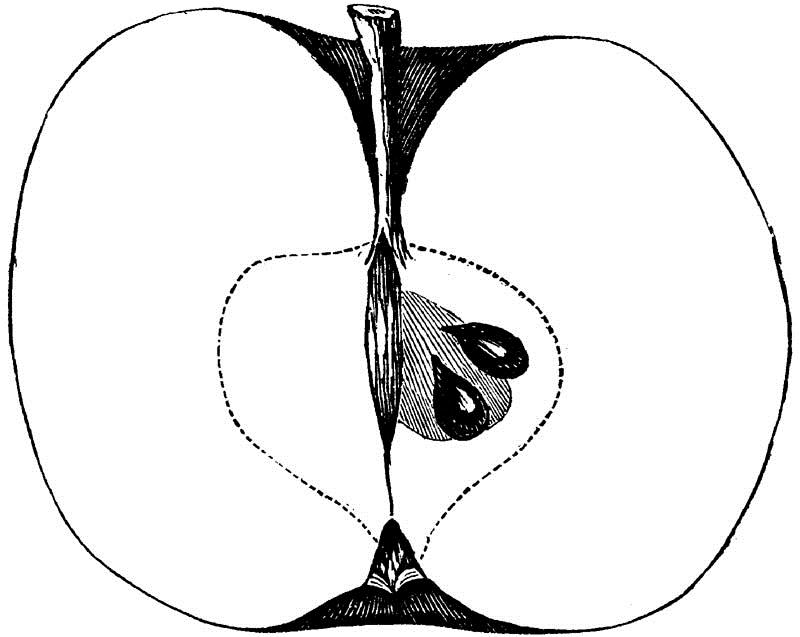
Fig. 217.—FARLEY RED.
A native of Kentucky, already somewhat extended northward. Tree healthy, moderately thrifty, very productive, making it small.
Fruit small, round or oblong, flattened or truncated at the ends, barrel shaped; Surface dull red stripes on yellow; Dots minute, indented, purplish.
Basin shallow, folded or plaited; Eye small, closed.
Cavity deep, acute, wavy, brown; Stem medium.
Core regular, turbinate, open, clasping the point of the eye; Seeds numerous, plump, angular; Flesh yellowish white, firm, juicy; Flavor sub-acid; Quality only good; Use, Mr. R. Ragan finds it one of his best market fruits; Season, March and April, keeping sound and very salable.
GlendaleBelieved to have originated near Glendale, Hamilton County, Ohio, where I obtained it from A.A. Mullet.
Tree vigorous, thrifty, spreading, well formed head, productive.
Fruit large, roundish, somewhat conical; Surface smooth, bright yellow, striped and clouded with bright red; Dots small, russet.
Basin deep, abrupt; Eye small, closed.
Cavity medium, wavy, green; Stem long.
Core open; Seeds numerous, medium; Flesh yellowish, tender, juicy; Flavor very mild sub-acid, almost saccharine, rich; Quality good; Use, table; Season, September, October.
HagloeThis foreign variety has the general aspect of a Russian apple both in tree and fruit.
Excellent for cooking, highly esteemed by the market gardeners of New Jersey, where it is much grown.
Tree healthy, vigorous, round headed, productive; Shoots stout, blunt; Foliage large, light green.
Fruit medium to large, round, somewhat flattened; Surface pale yellow, distinctly striped and splashed bright red or carmine, covered with white bloom.
Basin small, regular; Eye small, closed.
Cavity wide, regular; Stem short, thick.
Flesh whitish, not fine-grained, breaking, juicy; Flavor acid; Quality good; Use, kitchen and market only; Season, August.
HannahAUNT'S, not AUNT HANNAH of Massachusetts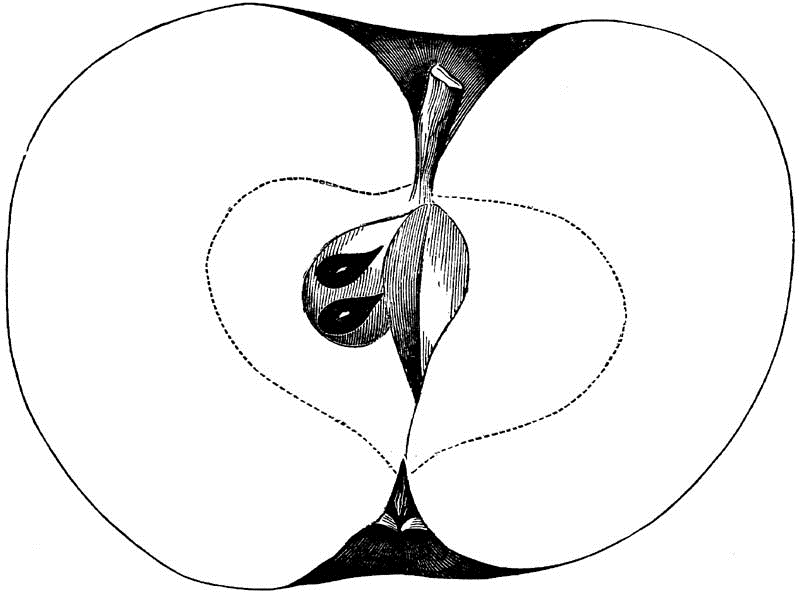
Fig. 218.—HANNAH.
This large and rather handsome fruit is found in many parts of the country, but is not largely cultivated. Its occurrence among Southern emigrants would lead us to suspect that they might have brought it with them.
Fruit large, showy, round, somewhat flattened, regular, sometimes unequal; Surface rather smooth, pale yellow, mixed, distinctly striped and splashed crimson and carmine; Dots scattered, large, gray.
Basin medium, abrupt, regular, often slightly russeted; Eye medium but long, closed.
Cavity wide, wavy, acute, deep, brown or green; Stem short to very short.
Core round, flattened or wide, regular, open; Axis very short; Seeds numerous, short, plump; Flesh light, yellowish white, breaking, tender, juicy; Flavor sub-acid, aromatic, peculiar, not agreeable to some palates; Quality only good; Use, kitchen, market, drying; Season, October to December.
Herefordshire Pearmain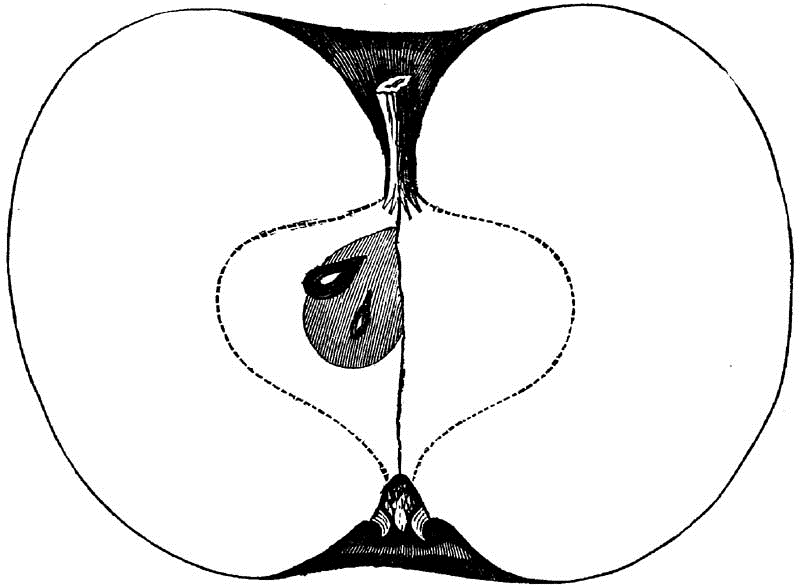
Fig. 219.—HEREFORDSHIRE PEARMAIN.
This is supposed to be an old English variety which has reached certain portions of the Western States from the East, though now rarely seen there, as its place has been taken by other Pearmains of American origin and more vigor, such as the Long Island Pearmain, described on another page. Tree slender and slow grower, medium size, very productive.
Fruit small to medium, roundish, slightly conic, truncated sharply; Surface smooth, deep red, splashes dark or maroon on rich yellow, which only shows where the fruit has been shaded by a leaf; Dots numerous, small, yellow.
Basin wide, regular, abrupt; Eye medium, open, reflexed.
Cavity medium, regular or wavy, green; Stem mostly short, stout, sometimes quite thick.
Core wide, turbinate, closed, regular, clasping the eye; Seeds numerous, small, pointed, dark, some imperfect; Flesh deep yellow, firm, breaking, very fine-grained, juicy; Flavor rich, sub-acid, aromatic, vinous, spicy, very agreeable; Quality best; Use, dessert; Season, December to February.
Especially adapted to amateur collections.
Hewes' Crab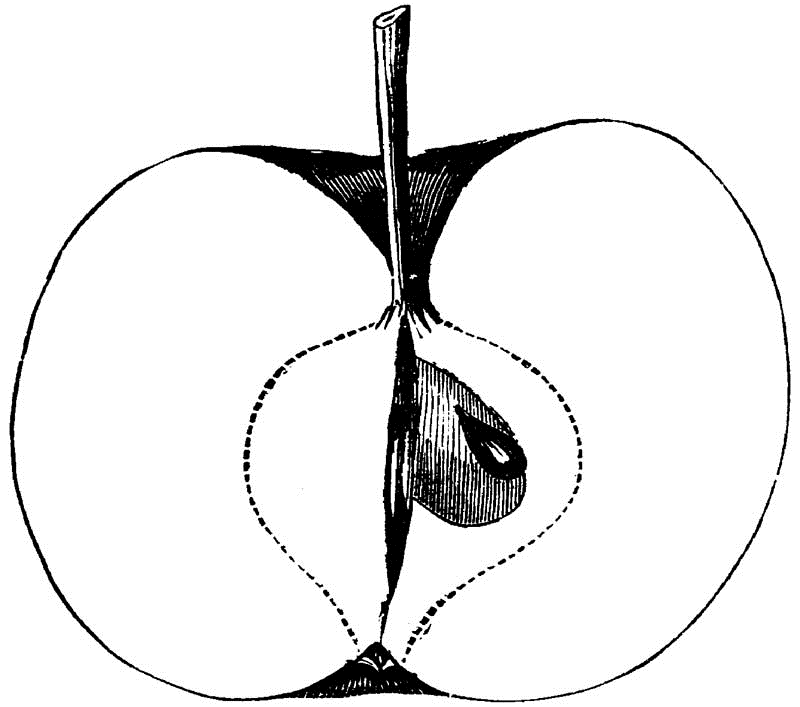
Fig. 220.—HEWES' CRAB.
From Virginia. A famous cider apple, found in all extensive and good cider orchards. Tree of slender growth, but makes a large, spreading top, immensely productive alternate years, long lived; Twigs slender; Foliage sparse.
Fruit quite small, round, somewhat flattened, regular; Surface mixed, striped, purplish red on yellow; Dots numerous, large, pale or fawn.
Basin shallow; Eye small, closed.
Cavity deep, regular; Stem long, red.
Core round, regular, open, clasping; Seeds large, pointed; Flesh firm, yellowish and greenish, juicy; Flavor acid, rich; the must is very heavy; Quality best for cider; Season, November to January. Also useful for cooking, except on account of its small size; the rich and piquant acid makes it a particularly desirable ingredient in mince-pies.
In Kentucky there is a variety of this apple known as Beeler's Crab, with fruit of similar characters, but the tree is a better grower.
HubbardstonHUBBARDSTON NONSUCH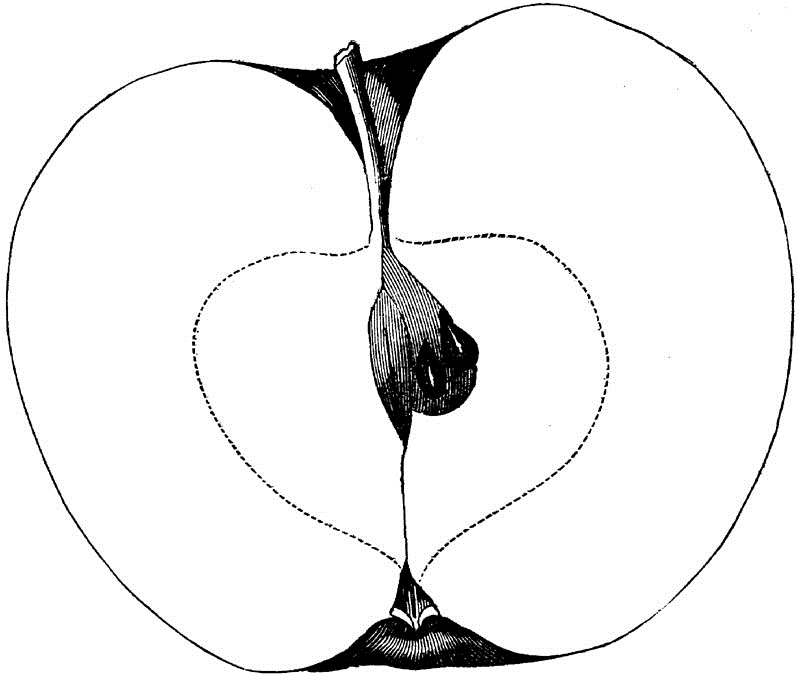
Fig. 221.—HUBBARDSTON.
This fine apple originated in Hubbardston, Massachusetts. Tree vigorous, healthy, productive, early bearer, round-leaved, branching. At one time this and the Baldwin were confounded and mixed in some Western collections.
Fruit large, fair, handsome, round, somewhat ovate, tapering both ways from the middle, regular; Surface often uneven, yellow, covered with mixed red and broken stripes, presenting a rich brownish appearance; Dots scattered, gray, prominent.
Basin abrupt, wide, regular, leather-cracked, or russeted, or both; Eye medium or small, open.
Cavity wide, regular, brown; Stem medium or short.
Core large, heart-shaped, regular, sometimes partially open, clasping the eye; Seeds few, pointed; Flesh yellow, breaking, fine grained, juicy; Flavor acid, sub-acid, rich; Quality very good; Use, cooking early, table when perfectly ripe; Season, November, December.
KrowserOrigin Berks County, Pennsylvania, where I found it very popular as a productive winter apple for all purposes. Tree vigorous, healthy, large, spreading, and very productive.
Fruit medium to large, round, slightly conic, regular; Surface rather smooth, pale yellow, nearly covered with red, and splashed carmine.
Basin small, folded; Eye medium, closed.
Cavity medium; Stem short to medium.
Flesh whitish, tender, juicy; Flavor mild sub-acid, rich, agreeable; Use, a good market fruit; Season, December to March.
Large Striped Pearmain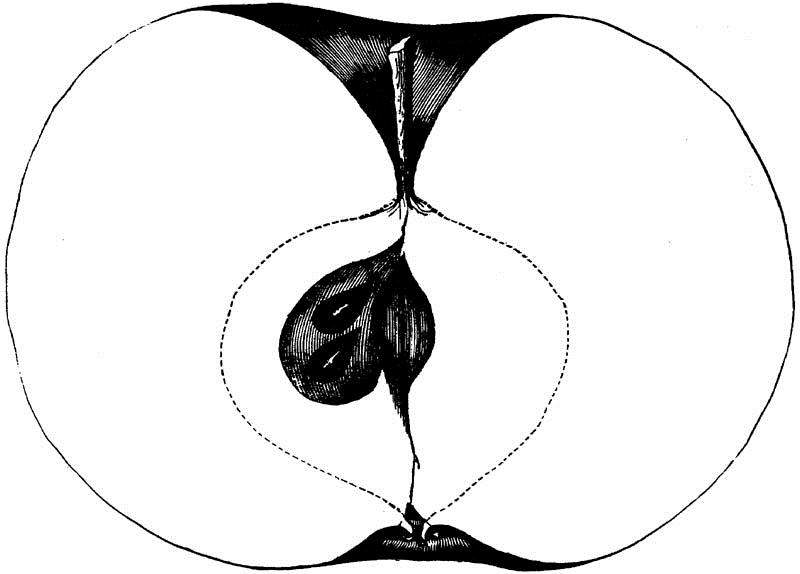
Fig. 222.—LARGE STRIPED PEARMAIN.
This choice Western apple is supposed to have originated in Kentucky—possibly further South. It is now to be found in Eastern Ohio, Southern Indiana and Illinois, and in Missouri. Much grown in Kentucky. In all places it seems to be doing well, and giving entire satisfaction, excepting that the bark bursts near the ground even in bearing trees, root-grafted.
Tree vigorous, thrifty, spreading, productive; Shoots rather slender, dark; Foliage dark green, abundant on young trees.
Fruit large, round, flattened, regular, fair, handsome, though not so beautifully colored as some others; Surface smooth, mixed, splashed and striped, pale purplish red on yellow, which shows through the shading; Dots minute, indented, gray, so that the fruit has a general gray appearance.
Basin medium, regular, sometimes cracked; Eye small, closed.
Cavity wide, wavy, rather deep, brown; Stem short, medium, or rather long.
Core roundish, medium, regular, open; Seeds numerous, large, angular, some imperfect; Flesh yellow, breaking, somewhat coarse-grained, juicy; Flavor sub-acid; Quality quite good; Use, market, kitchen, table; Season, December to February.
In the West it is more flattened than in Ohio, becoming in large specimens almost a flat or oblate apple. Highly recommended for commercial orchards, whether for shipping North or South—particularly the latter.
Lewis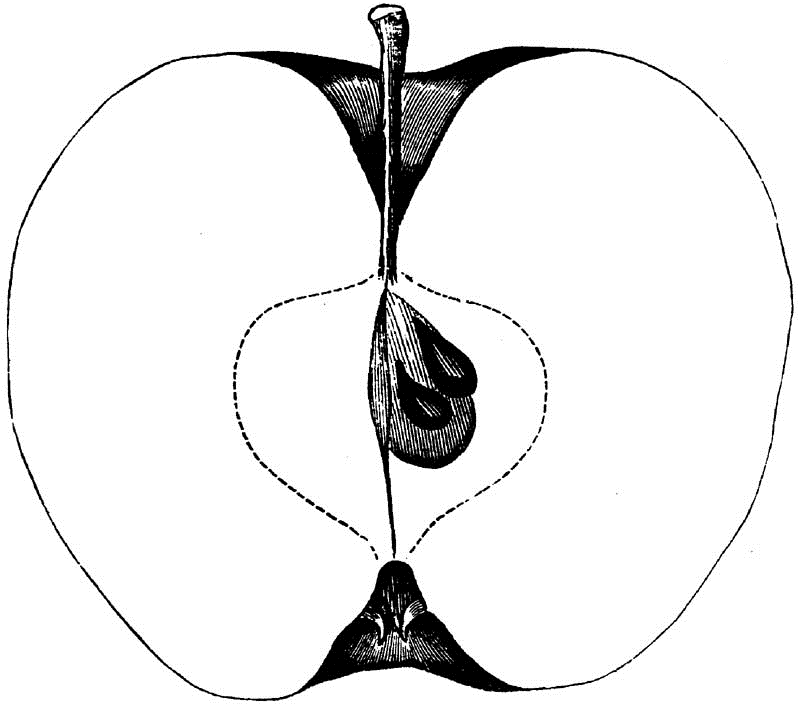
Fig. 223.—LEWIS.
This delicious apple originated in Decatur County, Indiana, near Greensburgh, and was introduced to my notice by one of the early pomologists of the region, a nurseryman by the name of Lewis, from whom I obtained my trees after he had introduced me to the original, which I found to be vigorous, healthy, upright, spreading and productive.



